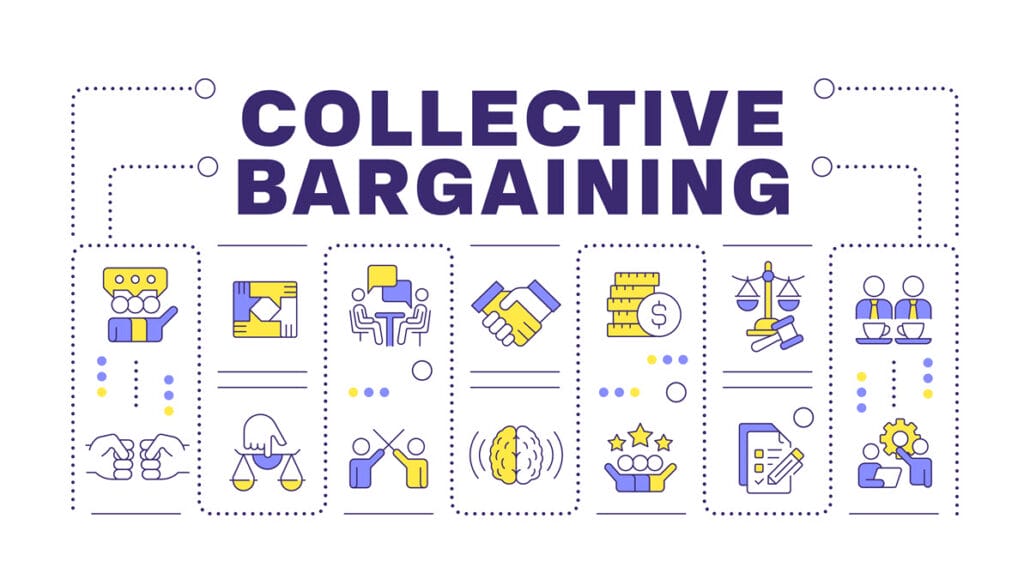Labor union negotiations are critical processes where unions and employers negotiate working conditions, wages, and benefits. In this article, you’ll learn about establishing a collective bargaining agreement, key negotiation steps, and strategies for success. We’ll cover forming a bargaining committee, preparing for negotiations, and reaching agreements.
Key Takeaways
- Understanding collective bargaining agreements (CBAs) is essential for successful labor union negotiations, as they outline employment terms and must be ratified by union members.
- Preparation and formation of a diverse bargaining committee are critical steps that enhance negotiation outcomes and ensure that all worker interests are represented.
- Maintaining good faith bargaining practices and positive employee relations fosters trust, facilitates open communication, and increases the likelihood of reaching mutually beneficial agreements.
A Brief History of Labor Unions
The history of labor union activity in the United States dates back to the late 18th century, when the first union was established by Philadelphia shoe makers in 1794. Europe also played a major role in establishing unions, which at that time were primarily aimed at creating safer working conditions. Employees in industries such as mining, manufacturing, railroads, and agriculture faced significant safety hazards on the job. Worker safety slowly but surely improved with the persistent aid of unions.
Both the U.S. and Canada recognize Labor Day in early September to recognize and celebrate workers’ rights. The event was first celebrated in New York City in 1892 and became a U.S. national holiday in 1894. Other parts of the world celebrate May 1 as International Workers’ Day. The roots of this holiday was inspired by Australian masons who organized a mass work stoppage, protesting long and unsafe working hours.
Despite a decline in union membership since the mid-20th century, unions continue to play a vital role in labor relations; they represent around 10% of the workforce today, most of which are in the public sector.
Understanding Labor Union Negotiations
Labor unions are organizations formed by workers to advocate for improved pay, benefits, and working conditions through negotiations with employers. With a democratic structure, union members elect leaders to make decisions that best represent their interests.
Bargaining is often initiated when a current contract is nearing expiration or when a new bargaining unit is formed or represented. This process, known as collective bargaining. It involves select employees who negotiate contracts with their employers to determine their terms of employment.
Key Terms in Collective Bargaining Agreements
A collective bargaining agreement (CBA) serves as a written, legal document that sets out the terms and conditions of employment between the union and the employer for a specified period, usually two to five years. The agreement could be relatively small (10 pages or less) or very large (over 100 pages). It can be very general, or so detailed that it includes everything in the employee handbook. The size often depends on the size and complexity of the company or union, but other factors can be at play as well.
A bargaining unit is a group of employees described in a collective bargaining agreement. The bargaining unit can include employees that aren’t in the union; however, employees in a bargaining unit always have the option to be represented by a union. A bargaining unit is usually defined by the unit’s roles, job classification or location.
The National Labor Relations Act (NLRA), passed in 1935, encourages collective bargaining and protects the rights of employees to engage in union activities. Understanding labor laws like the NLRAs is essential for HR managers to negotiate effectively.
A CBA outlines mandatory subjects, which are terms of employment that can’t be changed without the opportunity for negotiation by the union and the employer. If one party desires to negotiate a mandatory subject through collective bargaining, the other party can’t refuse to bargain over the mandatory subject.
In any negotiation process, it is critical to recognize the importance of a CBA. Familiarity with the collective bargaining process and key elements of a CBA helps both union members and employers navigate negotiations more effectively, leading to fair and mutually beneficial outcomes.
Key Steps in the Collective Bargaining Process

The collective bargaining process is a structured method where union representatives negotiate on behalf of workers to reach agreements that must be ratified by the union membership. This process involves continuous dialogue and negotiation until an agreement is achieved. It begins with forming bargaining teams, gathering information, and exchanging proposals until a mutual agreement is reached.
The result of the collective bargaining process is a legally binding contract that covers mandatory subjects, such as wages, hours, and working conditions. Following these key steps allows both parties to work toward a fair and equitable union contract that addresses the needs and interests of all stakeholders involved.
Forming a Bargaining Committee
Forming a bargaining committee is one of the first steps in the collective bargaining process. This committee represents the interests of the union members during negotiations with the company. Including individuals with diverse experiences ensures that the needs of all represented employees as well as the employer are considered during negotiations.
Members of the bargaining committee must understand their duties and responsibilities. This includes being well-versed in the collective bargaining process and the specific issues at hand. A well-prepared committee can effectively negotiate on behalf of union members, leading to a more successful and satisfactory agreement for all parties involved.
Preparing for Negotiations
Preparation is a critical phase in the negotiation process. Bargaining teams from both parties typically evaluate the existing contract to pinpoint areas needing changes. While most union contracts are negotiated over a relatively short face-to-face period, the preparation can take significantly longer. Knowing both the company’s and the union’s objectives can improve negotiation outcomes.
Strategic planning and gathering input from various stakeholders can help to formulate effective proposals. Adequate preparation and strategic planning mitigate stress and lead to more productive bargaining negotiations. HR professionals must avoid the common mistake of coming unprepared or underprepared to negotiations.
Conducting Negotiation Sessions
Formal negotiation sessions are crucial for both parties to listen to each other’s ideas and priorities. These sessions usually involve multiple rounds where both parties present and debate their proposals. Each session involves presenting proposals, engaging in discussions, and making counteroffers.
Documenting discussions during negotiation sessions ensures transparency and accountability. This practice ensures that both sides remain aligned and can refer back to the agreed-upon points as negotiations progress.
Reaching a Tentative Agreement
A tentative agreement is a preliminary accord reached during negotiations. This agreement outlines the key terms and conditions to be finalized. It includes mandatory subjects like wages, benefits, working conditions, and management rights. A thorough understanding of the contents—and implications—of a tentative agreement is critical. This pre contract stage, sometimes referred to as the first contract, significantly influences the outcomes of labor union negotiations moving forward.
Once a tentative agreement is reached, union members must vote on it through a ratification vote to determine if the majority accepts the proposed terms. This step, outlined in more detail below, is crucial in ensuring that the agreement has the support of the majority of union members and can be implemented effectively.
Ratification Vote
The ratification vote is a critical step in the collective bargaining process. When a tentative contract agreement is reached, a review with constituency groups, a ratification meeting, and employee voting occur. The bargaining unit holds a vote to accept or reject the tentative agreement, and a contract is not considered to be in effect until it is ratified by the union membership.
The contract is ratified if a majority of the votes cast are in favor of it. If the majority of the bargaining unit votes no on the contract, the bargaining committee and the company typically restart negotiations to reach a new agreement. This process ensures that the final contract agreement reflects the will of the union members.
Essential Elements of a Collective Bargaining Agreement (CBA)

A collective bargaining agreement (CBA) is a contract between a labor union and the employer that sets out the terms and conditions of employment for a specified period, usually two to five years.
Key components of a collective bargaining agreement include mandatory subjects like wages, benefits, working conditions, and management rights. These elements are critical in ensuring that the interests of both workers and the employer are addressed. Negotiating these components effectively can lead to a more harmonious and productive workplace for employees and employer alike.
Wages and Benefits
HR and union negotiations typically cover various aspects of compensation, including wages, bonuses, and benefits such as medical insurance and retirement plans. Wages and benefits are generally the most contested sections within a collective bargaining agreement. Wage negotiations often result in higher pay and improved benefits for union employees.
Healthcare provisions in CBAs can include insurance coverage, co-pays, and benefits for dependents. Retirement benefits encompass pensions, 401(k) plans, and other retirement savings options. These benefits ensure the long-term well-being and financial security of union employees.
Working Conditions
Work hours should be clearly defined in a CBA, including regular start and end times, along with considerations for overtime, holiday pay, and shift swaps. Negotiating scheduling procedures to accommodate employee needs ensures flexibility and predictability in union employees’ work shifts. These cannot be changed without a new CBA.
Comprehensive safety measures should be established to ensure a safe working environment that meets both labor law standards and employee expectations. Regular inspections, maintenance protocols, and mandated training programs on safety procedures are the status quo. These elements enhance employee awareness and preparedness and ensure workers are kept safe.
Management Rights and Responsibilities
Standard clauses in a collective bargaining agreement outline employer management’s authority, enabling effective oversight and operation of their business. These clauses define the authority of employer management to operate business functions without union interference. However, management must ensure that their decisions do not violate union contract terms.
The management rights clause contains standard language that guarantees the company’s right to run its business operations as it sees fit, requiring little involvement from HR managers. This balance allows management to maintain control while respecting the negotiated terms.
Good Faith Bargaining Practices

Employers have a legal duty to bargain in good faith with the union as per the National Labor Relations Act (NLRA). Section 8(d) of the NLRA outlines the obligations within the duty to bargain in good faith. Employers should avoid negotiating directly with represented employees instead of through the union to prevent unfair labor practice.
Honesty and integrity are crucial for effective bargaining and foster credibility among negotiators. Using precise language in each written agreement is necessary to prevent misunderstandings and ensure clear communication of intentions.
Establishing rapport with union representatives prior to negotiations enhances collaboration and credibility during labor relations.
Resolving Disputes During Negotiations
Disputes during the collective bargaining process are common, and state law generally specifies methods for resolving these disputes. Unfair labor practices which lead to disputes can occur when employers make unilateral changes to wages, hours, or working conditions without notifying the Union.
Prompt and effective dispute resolution prevents prolonged negotiations and facilitates reaching a satisfactory agreement. Utilizing mediation and arbitration can be effective strategies for resolving disputes and maintaining the negotiation process.
Declaring an Impasse
If an employer and union are not able to reach an agreement through negotiations, the parties may declare an impasse. This means that they cannot resolve their disputes through further bargaining. If the Public Employment Relations Board (PERB) certifies the impasse, the parties will be assigned a state mediator.
Mediation and Arbitration
In labor relations, mediation is a process where a neutral third party assists the conflicting parties in finding a mutual agreement. If parties cannot reach an agreement, methods like mediation, arbitration, or even strikes and lockouts can be employed to resolve contract disputes.
Arbitration involves a third party who makes a binding decision to resolve the dispute when mediation fails. Mediation seeks a mutual agreement facilitated by a neutral party, whereas arbitration results in a binding decision from an arbitrator when mediation does not succeed.
Worker Strike!
A worker strike may occur, where employees picket outside the company and refuse to work, after union negotations between employees and employers reach an impasse. To conduct a strike, union leaders must first call for a strike and then achieve a successful vote from its members before the strike can occur.
Strikes can be financially harmful to the striking worker due to lower pay, and to the company due to decreased productivity. They tend to strain the relationship between employee and employer, and can open up legal hassles for both sides. In the event of a strike, it is in the interest of both parties to come to an agreement as soon as possible.
Handling Unfair Labor Practice Charges
Handling unfair labor practice charges is a critical aspect of maintaining the integrity of the collective bargaining process. Activities that support union efforts are considered protected union activities. An unfair labor practice related to interference occurs when an employee perceives actions as a threat or a promise of a benefit linked to union activity.
Violating the NLRA can harm the negotiation process, potentially extending it or complicating it due to unfair labor practices being filed. Employers must adhere to the NLRA to avoid such complications and ensure a smooth and fair negotiation process.
The Role of HR Managers in Labor Union Negotiations

HR managers play a crucial role in labor union negotiations by balancing the interests of the company with employee relations. Often functioning in dual roles as experts in both labor relations and employee relations, HR managers, especially in smaller organizations, must protect the company’s interests while also strengthening the employer-employee relationship through good faith bargaining.
Effective communication between HR and union leaders is crucial for navigating the negotiation process successfully. HR managers must also understand represented employees’ needs, the company’s financials, and employer operations to effectively participate in union contract negotiations.
Maintaining transparent communication and keeping employees informed about the negotiation process helps HR managers prevent misunderstandings and foster a more collaborative environment among co workers.
Impact of Positive Employee Relations on Negotiations
A high level of positive employee relations can lead to smoother negotiations. It fosters trust and open communication between union representatives and management. Proactively addressing employee demands and grievances is essential for maintaining positive relations during negotiations. Effective negotiation by HR managers can prevent high employee turnover by fostering a comfortable workplace.
A collaborative approach in bargaining enhances the likelihood of reaching mutually beneficial written agreement, reducing conflict. The ratification process usually requires a clear communication plan to ensure all members understand and accept the terms of the agreement.
A unionized business with high employee engagement is more likely to have a successful negotiations process.
Summary
Navigating labor union negotiations can be complex, but with the right strategies and understanding, it is possible to achieve successful outcomes that benefit both employees and employers. Key steps include forming a bargaining committee, preparing thoroughly for negotiations, conducting effective negotiation sessions, and reaching a tentative agreement that is ratified by union members. Understanding the essential elements of a collective bargaining agreement and practicing good faith bargaining are crucial for a smooth negotiation process.
Maintaining positive employee relations and effectively resolving disputes during negotiations can significantly enhance the likelihood of reaching a fair and equitable agreement. HR managers play a pivotal role in balancing the interests of the company and the employees, ensuring transparent and effective communication throughout the process. By following these strategies, both parties can achieve a collective bargaining agreement that fosters a productive and harmonious workplace.


